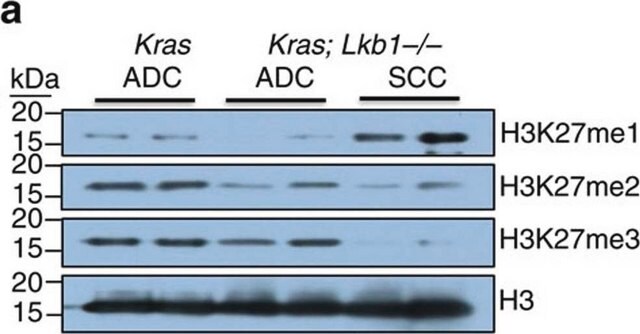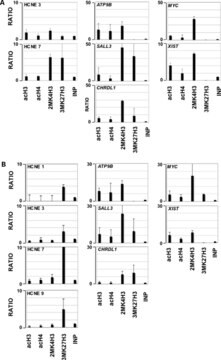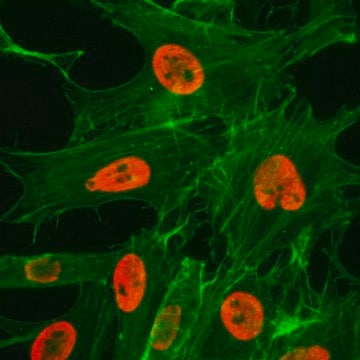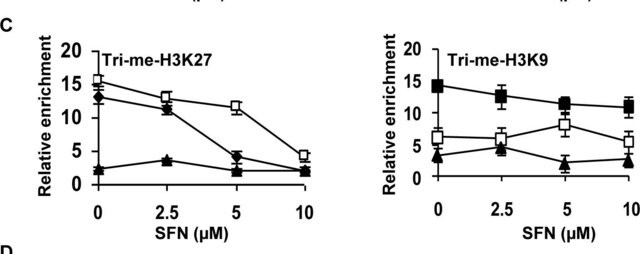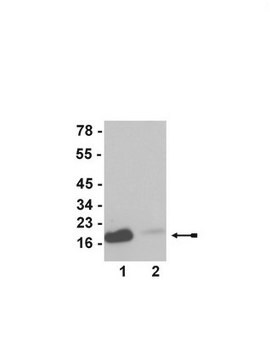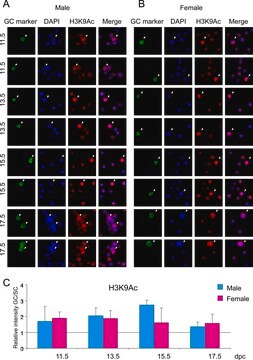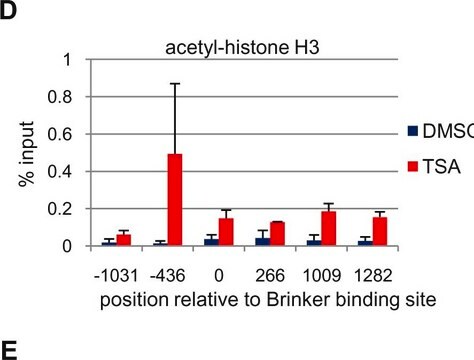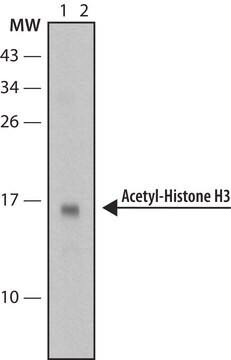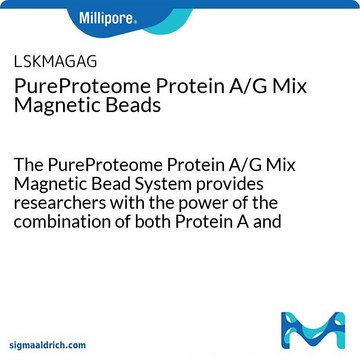Opis ogólny
Histon H3 (UniProt: P61830) jest kodowany przez gen HHT1 (znany również jako YBR010W, YBR0201, HHT2, SIN2, YNL031C, N2749) (Gene ID: 852295) u drożdży. Histon H3 jest podstawowym składnikiem nukleosomu. Nukleosomy owijają i zagęszczają DNA w chromatynę, ograniczając dostępność DNA do maszyn komórkowych, które wymagają DNA jako matrycy. Histon H3 może ulegać różnym modyfikacjom potranslacyjnym, które aktywują lub hamują ekspresję genów. Histon H3 może ulegać mono-, di- lub trimetylacji. Wykazano, że trimetylowany H3K27 jest ściśle związany z nieaktywnymi promotorami genów, a monometylowany H3K27 jest związany z aktywnymi promotorami. Dimetylowany H3K27 ma wzór dystrybucji podobny do H3K27. Histon H3 może również ulegać acetylacji przy Lys9, 14, 18, 23, 27 i 56. Acetylacja histonu H3 prowadzi do aktywacji transkrypcji. Acetylacja histonów definiuje otwartość chromatyny, ponieważ acetylowane histony nie mogą być tak dobrze upakowane jak histony deacetylowane. H3K27ac jest ważnym znacznikiem enhancera, który może rozróżniać aktywne i nieaktywne elementy enhancera, a proksymalne geny enhancera, które nie są wzbogacone w H3K27ac, wykazują niższy poziom ekspresji w porównaniu z przeciętnym proksymalnym genem enhancera. Wykazano, że ilość H3K27ac stopniowo spada od najwcześniejszego stadium przedjądrowego do stadium 8-komórkowego, co odpowiada głównej aktywacji genomu embrionalnego (EGA), po której następuje ponowna acetylacja H3K27 od stadium moruli, towarzysząca pierwszej specyfikacji linii komórkowej w zarodkach IVF. U Drosophila, H3K27ac jest obecny na wysokim poziomie we wczesnych zarodkach i spada po 4 godzinach wraz ze wzrostem poziomu trimetylowanego H3K27. (Ref.: Creyghton, MP et al. ( ). Proc. Natl. Acad. Sci. USA 107(50); 21931-21936; Tie, F et al (2009). Dvelopment 136 (18); 3131-3141).
Specyficzność
Rozpoznaje histon H3 acetylowany na lizynie 27.
Immunogen
Epitop: Lys27
Liniowy peptyd sprzężony z KLH odpowiadający 11 aminokwasom z N-końcowego regionu ludzkiego histonu H3 acetylowanego na lizynie 27.
Zastosowanie
Analiza ChIP-seq: Immunoprecypitację chromatyny przeprowadzono przy użyciu zestawu Magna ChIP HiSens (nr kat. 17-10460), 2 µl przeciwciała anty-acetylo-Histone H3 (Lys27) (nr kat. 07-360), 20 µl kulek Protein A/G i 1e6 usieciowanej chromatyny komórek HeLa, a następnie oczyszczono DNA przy użyciu kulek magnetycznych. Biblioteki zostały przygotowane z próbek Input i ChIP DNA przy użyciu standardowych protokołów z adapterami Illumina z kodem kreskowym i analizowane na instrumencie Illumina HiSeq. Ponad czternaście milionów odczytów z plików FastQ zmapowano za pomocą Bowtie (http://bowtie-bio.sourceforge.net/manual.shtml) po usunięciu tagów TagDust (http://genome.gsc.riken.jp/osc/english/dataresource/). Piki zostały zidentyfikowane przy użyciu MACS (http://luelab.dfci.harvard.edu/MACS/), z pikami i odczytami wizualizowanymi jako niestandardowa ścieżka w UCSC Genome Browser (http://genome.ucsc.edu) z plików BigWig i BED. Najwyższe 25% pików zidentyfikowanych w zbiorze danych 07-360 wykazało 96% pokrycie z pikami zidentyfikowanymi w ścieżce ENCODE H3K27Ac BROAD Histone dla HeLa S3.
Anti-acetyl-Histone H3 (Lys27) Antibody to królicze przeciwciało poliklonalne do wykrywania histonu H3 acetylowanego na lizynie 27. Znane również jako Anti-H3K27ac, to przeciwciało zostało opublikowane w recenzowanych czasopismach i jest specyficzne zweryfikowane przez dot blot (DB) i zwalidowane w ChIP, ChIP-seq, WB, DB, Mplex.
Kategoria badawcza
Epigenetyka i funkcje jądrowe
Podkategoria badawcza
Histony
Jakość
Evaluated by Western Blotting in acid extract of HeLa cells treated with 5 mM sodium butyrate.
Western Blotting Analysis: A 1:5,000 dilution of this antibody detected acetyl-Histone H3 (Lys27) in acid extract of HeLa cells treated with 5 mM sodium butyrate.cells
Opis wartości docelowych
17 kDa
Postać fizyczna
Królicza surowica poliklonalna z 0,05% azydkiem sodu i 30% glicerolem.
Nieoczyszczony
Przechowywanie i stabilność
Przechowywać przez 2 lata w temperaturze -20°C od daty wysyłki. Należy unikać wielokrotnego zamrażania i rozmrażania. Aby uzyskać maksymalny odzysk produktu, należy odwirować oryginalną fiolkę po rozmrożeniu i przed zdjęciem korka.
Komentarz do analizy
Kontrola
Białka ekstrahowane kwasem z komórek HeLa traktowanych maślanem sodu
Inne uwagi
Stężenie: Stężenie specyficzne dla danej partii można znaleźć w certyfikacie analizy.
Informacje prawne
UPSTATE is a registered trademark of Merck KGaA, Darmstadt, Germany
Oświadczenie o zrzeczeniu się odpowiedzialności
O ile nie określono inaczej w naszym katalogu lub innej dokumentacji firmy dołączonej do produktu(-ów), nasze produkty są przeznaczone wyłącznie do użytku badawczego i nie mogą być wykorzystywane do żadnych innych celów, w tym między innymi do nieautoryzowanych zastosowań komercyjnych, zastosowań diagnostycznych in vitro, zastosowań terapeutycznych ex vivo lub in vivo lub jakiegokolwiek rodzaju konsumpcji lub zastosowania u ludzi lub zwierząt.
Ta strona może zawierać tekst przetłumaczony maszynowo.


